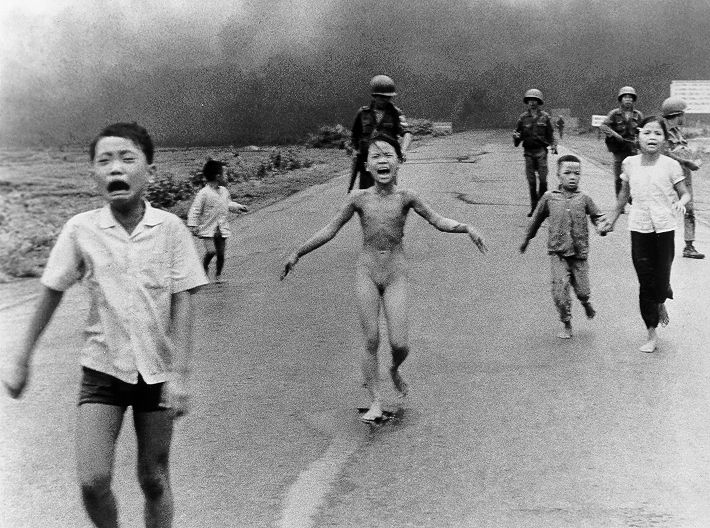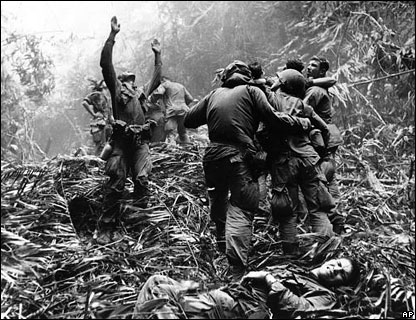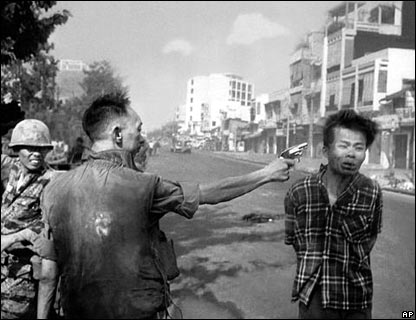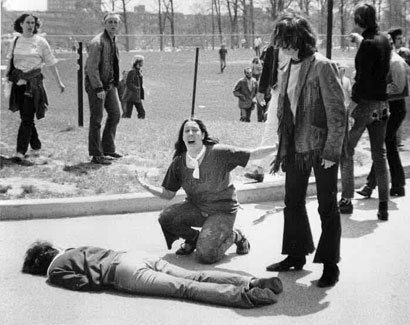
ENG101.CV1 -- English Composition I
Prof. Eileen Joy (Fall 2006)
Essay 2
Historical Image Analysis: The Vietnam War

Fig. 1. Vietnam Napalm, Trang Bang (1972), by Huynh Cong (Nick) Ut (copyright Associated Press)
| In-Class Draft Workshop | Monday, Oct. 30 |
| Final Draft Due | Monday, Nov. 6 |
| Format | 4 pages minimum, double-spaced, 1"-margins |
Overview
For this assignment, you will select an iconic (meaning important or enduring) photograph (not a painting, video, or other media) related to the Vietnam War, describe it to the readers and analyze how that photograph “defines the war ” or presents a particular view of its historical moment.
Background
We know that history is documented by two kinds (or maybe more) of print texts: the first being the archival document (like the actual parchment Declaration of Independence that we could see in a museum) as well as by historical accounts written by witnesses (“I was there”) or by historians (“Here’s what happened at the signing of the Declaration of Independence….”). Witness and historian accounts, of course, each present a particular perspective of the event. When we think of history, we often think of texts.
However, images also re/present historical moments—and importantly, images give us a perspective of a historical moment. Because visual images are powerful, we sometimes can see the picture of an event in our mind’s eye long after we forget any written account of the event. Many of you probably recall the events of 9/11 through the images you saw on television or in magazines, more so than you recall it through, say, the 9/11 Commission Report. These images, horrifying as they may have been, ultimately represent not only an actual moment in history; they also symbolize what the event means to us personally and to our nation.
Our historical memories are filled with such visual images, such as the one above of the naked ten-year-old Vietnamese girl running down a street having survived a napalm attack during the Vietnam War. Even if we weren’t alive or have no historical recollection of an event, these images represent a version of that history to us. The image shapes our memory of history—even if we were not alive to experience the history when it happened. The photograph above, for example, paints a portrait of the war that strikes a very different chord within us than, say, this photograph:

Figure 2. Wounded paratrooper of the 101st Airborne guides a medical evacuation helicopter through the jungle foliage to pick up casualties (Hue, South Vietnam, in 1968)
Or this one:

Figure 3. South Vietnamese Gen. Nguyen Ngoc Loan executing a Vietcong officer (by Eddie Adams)
Or this one:

Figure 4. Kent State University student protest against Vietnam War (1970) ends in four student deaths (by John Filo, a photojournalism student)
Getting Started With This Assignment
You will need to locate a photograph that is related top any aspect of the Vietnam War. You can try to find an image on-line using Google’s “Image” search. Sometimes these images are difficult to find on-line. Ask for help if you can’t find the image you want. You may also find images in a book or magazine. You will need a copy of the image to accompany your paper. Please be careful to find a photograph that has an obvious perspective; in other words, it is framed in a particular way by the photographer to "make a statement," to "say something" specific about the war. In other words, it should be a photograph that is clearly framed from a subjective point-of-view (as opposed to an objective point-of-view, which would be neutral and unbiased).
Almost all of the photographs that you might want to use are copyrighted—even if they are on the Internet. We’ll talk in class about how to work with those images and give credit in your paper to the photographer and web site or book where you found it.
Here are some websites you might find useful:
After you find the photograph, you will want to: (1) describe and analyze the image, and (2) think about the historical significance of that photograph. Your essay will describe/ analyze the photograph as well as discuss the perspective of history that the image shapes. You can even do some informal surveying of peers to find out what they think about the image.
Keep in mind that the perspective that is given may or may not be historically accurate, and it will most likely not be historically complete. That’s okay. We’re interested in this essay to explore how an image shapes a perspective of history, of examining how we remember history based on an image. We’re not so much concerned about whether or not that perspective is accurate, though we might discuss that in the essay, too.
Since, in your HIST111B class you have been (and will be) concentrating on issues of how people remember the past, and the different ways in which different people perceive the past, please feel free to bring in material you've read and discussed in this class into your analysis of your photograph.
Structure of Final Essay
Your essay should have, roughly, four sections:
1. Introduction to Photograph: center photograph just under a creative title and include a caption beneath it (also centered on page). Provide some specific contextual information about the photograph: who took it, where, when, and what is the general scene being depicted? What historical details can you provide, if any, about the "who, what, where, and when" of the photogaph?
2. More Broad Historical Context: provide one to two paragraphs worth of information, as you see fit, pertaining to the larger historical context of the photograph, that you think would help your reader better understand what your photograph is connected to on a more broad, historical level. This will likely entail information about the Vietnam War in general, but might also include information about specific events within that war--the My Lai Massacre, the Kent State shootings, the self-immolation of Buddhist monks, specific battles, etc. Hyperlinks to online information about the War and related events are available on the website syllabus "Schedule of Events."
3. Analysis of the Photograph:
What is the setting or scene? What action is happening or has happened? What features of the photograph do you first notice? What features do you notice upon closer inspection?
Who is in the photograph? Describe the physical characteristics of the people: what are they wearing? What do they look like? Describe their emotional or mental characteristics? What kind of expressions do they have?
Look at the way in which the photograph is framed--what is the angle from which it is taken; what features are in the foreground, the background, off to the side, etc.? What seems to be emphasized the most, and how do the different figures--human otherwise--intersect or stand apart in the photograph?
Why might this photograph have been taken? Why was this picture something that the photographer felt was important to capture? What draws you toward this photograph and make you interested in it?
What do you think about the historical moment that is captured in this photograph? What about the photograph makes you think that way? How does the photograph shape your understanding of the historical moment?
4. Conclusion: consider your experience of watching Oliver Stone's Platoon, reading Tim O'Brien's The Things They Carried, and now, thinking and writing about your photograph. Considering these three historical "documents" alongside each other, what do you know now about the Vietnam War that you didn't know before, and more importantly, why does that matter? [There is NO right or wrong answer to this question--it is philosophical in nature, and should be treated as such, but it is also asking you to consider, on a deeper level, why knowing anything at all about a past historical event might be meaningful to you, or to others. Please feel free to draw upon any discussions you may have had in the HIST111B course that you feel might pertain to your thoughts here.]
Works Cited Page: you should attached to your essay a Works Cited page that includes citations for any online resources you used in your essay, as well as the citation for where you found your photograph. Here are some examples of how that would look [also, click on links to see what I am citing and please note how citations that take up more than one line on a page are indented]:
1. Online Photograph:
Stone, Dana. "Bong Son, Vietnam, 1966." The Digital Journalist: Requiem. <http://www.
Ulevich, Neil. "Waist deep in the big muddy." Vietnam Memories.<http://www.watermargin.
2. Online Article or Webpage:
"My Lai Massacre." Wikipedia. <http://en.wikipedia.org/wiki/My_Lai_massacre>.
Lewis, Jerry M. and Thomas R. Hensley. "The May 4 Shootings at Kent State University: The
Search for Historical Accuracy." Kent State University. <http://dept.kent.edu/
Resources
Chapter 11 in The Allyn & Bacon Guide to Writing, "Analyzing Images" (pp. 293-300), is a good place to go first to get some initial pointers on how to analyze the rhetoric (i.e., the "argument") of visual images. This chapter mainly concentreates on the analysis of images in advertising, so it is only a start. Look also at Chapter 3 in Seeing and Writing, "Capturing Memorable Moments" (pp. 220-29 and 266-77, but also Susan Sontag's essay, "On Photography," pp. 292-94). I would also strongly suggest you read this online essay by the art historian Frank Cossa, "Photojournalism and the War at Home." Finally, for further assistance in understanding how photographers use their cameras to "frame" an image a particular way, go here (American Photography website) and follow the link for "Image Lab."
**This assignment represents an emended version of Prof. Sharon McGee's "Historical Image Analysis" assignment.